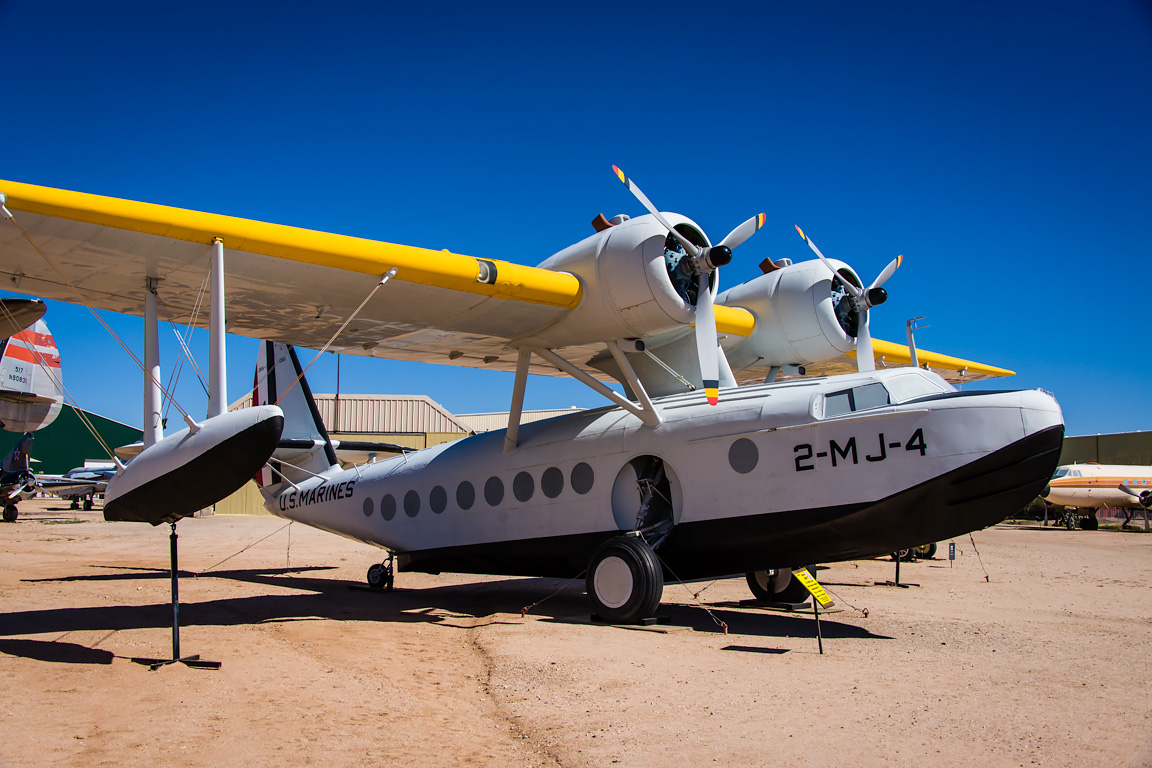Pima Air and Space Museum, Part 5
I spied this aircraft from a distance — it stood out because of the paint job, looking like a presidential plane. When I got close enough to read the lettering reading "UNITED STATES OF AMERICA", I was sure my initial impression was correct. This is a Douglas VC-118A Liftmaster, the militarized version of the civilian Douglas DC-6 airliner. This aircraft served for a time as the official Air Force One for President Kennedy. The VC-118A was subsequently replaced in that role by the jet-powered Boeing VC-137. However, this plane continued to be in use when the President was traveling to smaller airports which could not handle the VC-137 and for transporting lower-ranking VIPs.

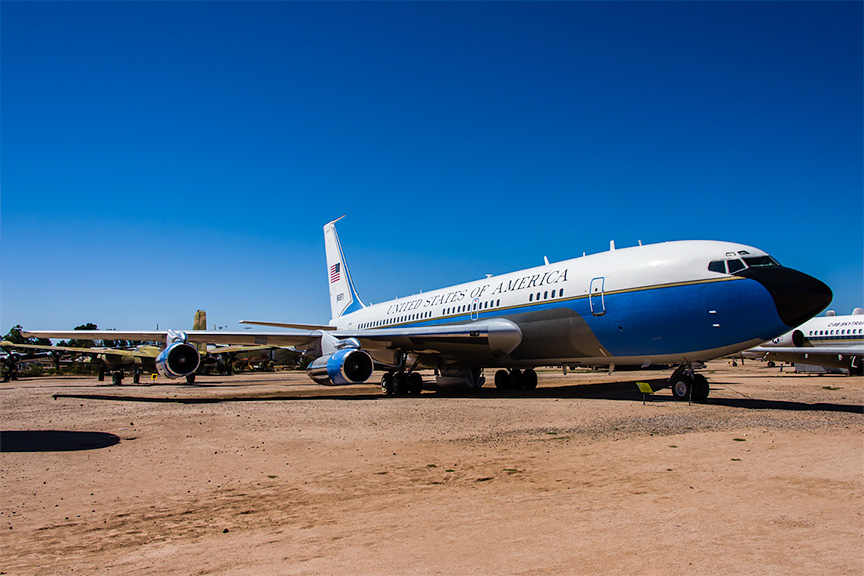 And next is the Boeing VC-137B which was the successor Air Force One as mentioned above.
It is the military version of a Boeing 707 with upgraded engines offering greater thrust. A couple additional aircraft were later obtained with specialized interior furnishings and advanced communications equipment.
And next is the Boeing VC-137B which was the successor Air Force One as mentioned above.
It is the military version of a Boeing 707 with upgraded engines offering greater thrust. A couple additional aircraft were later obtained with specialized interior furnishings and advanced communications equipment.
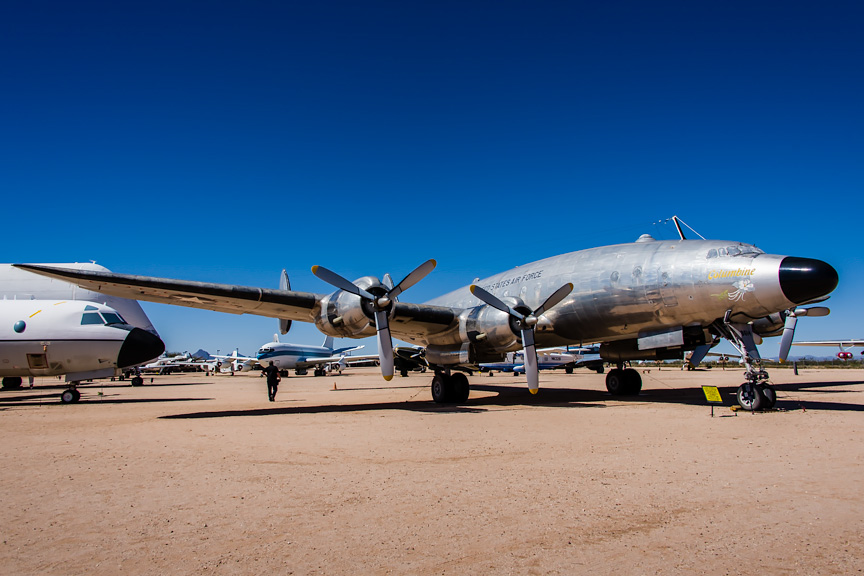 The next aircraft is a Lockheed C-121A Constellation based on the civilian Lockheed L-749 Constellation. In the 1950s, this aircraft attracted the attention of the U.S. Air Force, which bought ten of them for long-range VIP transports — they proved to be very popular and regularly carried high-ranking military and civilian VIPs.
The next aircraft is a Lockheed C-121A Constellation based on the civilian Lockheed L-749 Constellation. In the 1950s, this aircraft attracted the attention of the U.S. Air Force, which bought ten of them for long-range VIP transports — they proved to be very popular and regularly carried high-ranking military and civilian VIPs.
This exact plane was used by General Dwight D. Eisenhower and named "Columbine" after the state flower of Colorado.
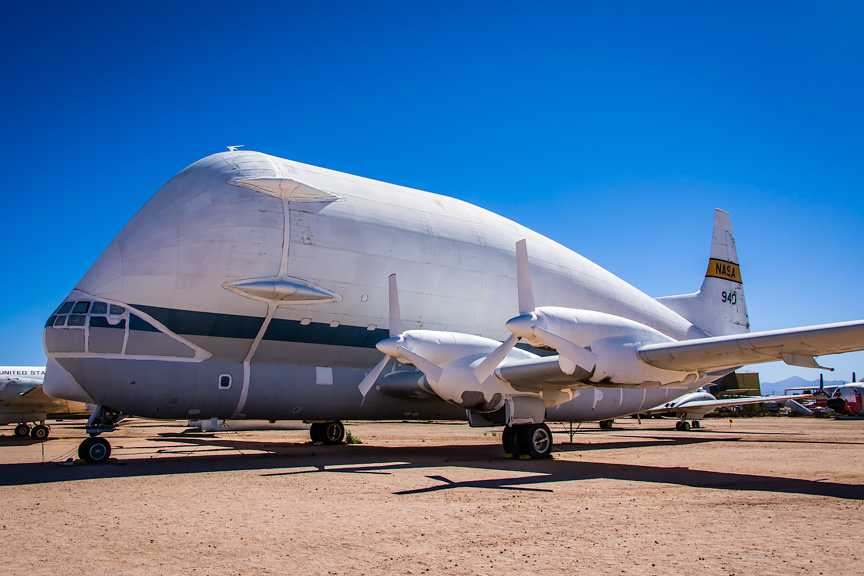 The next aircraft has to be one of the most unusual ever built — the Aero Spacelines 377SG Super Guppy (for some reason I always want to call it the "Pregnant Guppy"). It was developed to carry large but lightweight cargo such as rocket segments. Much of the Saturn rocket that powered the Apollo Program was transported in the Super Guppy.
The next aircraft has to be one of the most unusual ever built — the Aero Spacelines 377SG Super Guppy (for some reason I always want to call it the "Pregnant Guppy"). It was developed to carry large but lightweight cargo such as rocket segments. Much of the Saturn rocket that powered the Apollo Program was transported in the Super Guppy.
The majority of the airframe came from a former Pan American Airways airliner. However, the wings, engines and forward fuselage came from one of the Air Force's experimental turbo-prop powered YC-97J aircraft. This Super Guppy continued in use by NASA until 1991 when it was retired in favor of a younger Super Guppy.
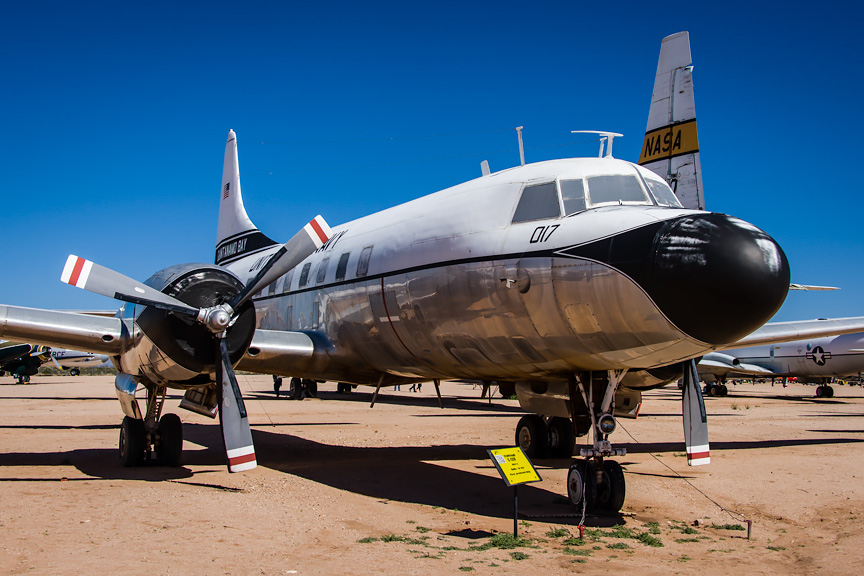 Next up is a Convair C-131 Samaritan which was an American twin-engine military transport produced from 1954 to 1956. It was the military version of the Convair CV-240 family of airliners. This and related aircraft were used by the United States Air Force (USAF) for medical evacuation and VIP transport and was thus designated with the "Samaritan" moniker.
Next up is a Convair C-131 Samaritan which was an American twin-engine military transport produced from 1954 to 1956. It was the military version of the Convair CV-240 family of airliners. This and related aircraft were used by the United States Air Force (USAF) for medical evacuation and VIP transport and was thus designated with the "Samaritan" moniker.
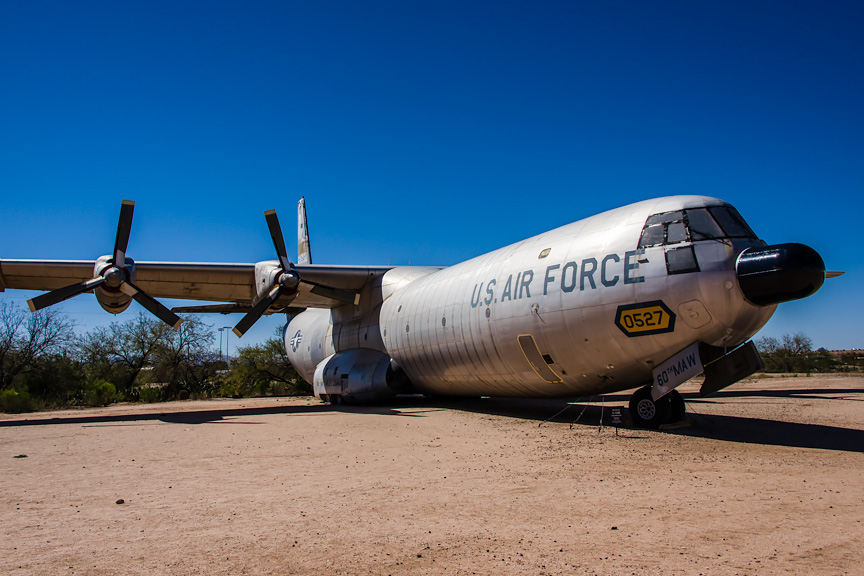 Here we see a Douglas C-133 Cargomaster. It was designed to meet the requirements for the USAF's Logistic Carrier Support System SS402L for a new strategic transport to replace the
C-74 Globemaster and C-124 Globemaster IIs that had preceded it.
Here we see a Douglas C-133 Cargomaster. It was designed to meet the requirements for the USAF's Logistic Carrier Support System SS402L for a new strategic transport to replace the
C-74 Globemaster and C-124 Globemaster IIs that had preceded it.
It featured a high-mounted wing, external blister fairings on each side for the landing gear, and rear-loading and side-loading doors which ensured that access to, and the volume of, the large cargo compartment were not compromised by these structures. The cargo compartment (90 ft/27 m in length and 12 ft/3.7 m high) was pressurized, heated, and ventilated.
It was in service from 1956 to 1971.
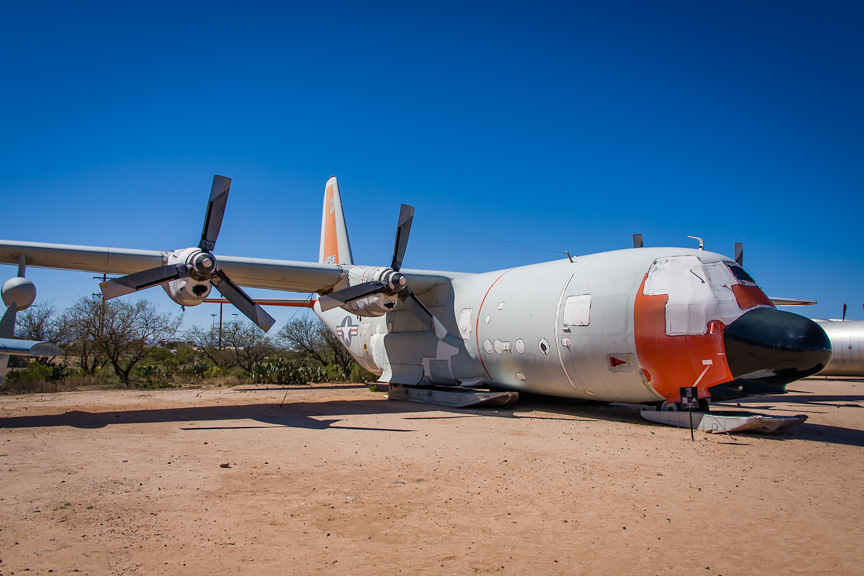 The "D" model of the Lockheed C-130 is a prime example of the adaptability of the Hercules. In the late 1950s the Air Force determined that there was a need for a new aircraft to support the "DEW Line" early-warning radar sites located on the far northern ice cap. Testing proved that the C-130 could be easily adapted to this job.
The "D" model of the Lockheed C-130 is a prime example of the adaptability of the Hercules. In the late 1950s the Air Force determined that there was a need for a new aircraft to support the "DEW Line" early-warning radar sites located on the far northern ice cap. Testing proved that the C-130 could be easily adapted to this job.
A total of twelve ski-equipped C-130Ds were built in 1958. The ski/wheel landing gear allowed the planes to operate from either a normal runway or from ice and snow. The Hercules is the largest aircraft ever equipped with skis. The success of the C-130D in the difficult and dangerous Arctic environment led to the conversion of more "Herks" for the U.S. Navy to support the operation of the numerous research stations in Antarctica. The C-130Ds served until the mid-1980s when they were replaced by newer ski-equipped LC-130Hs.
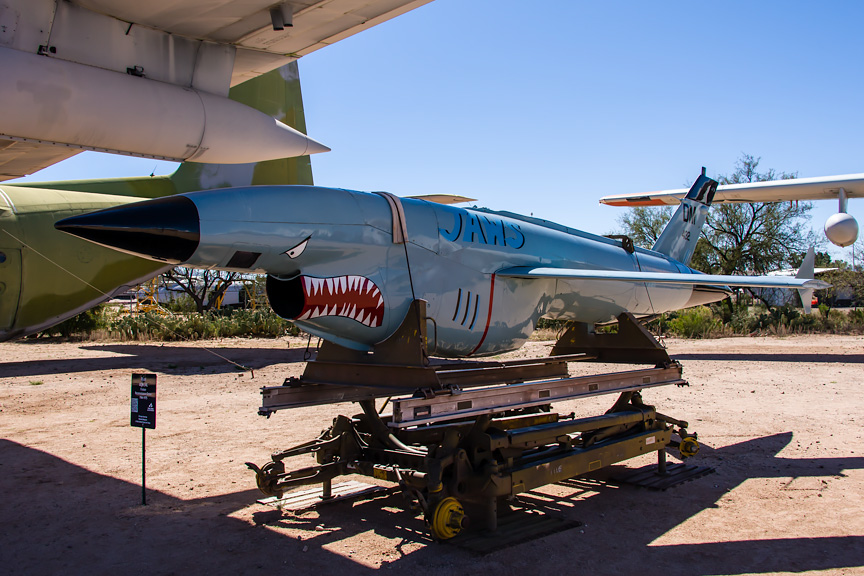 In the midst of all these transports is this relatively tiny Teledyne Ryan AQM-34L Firebee
low-altitude, photographic reconnaissance drone. They were launched and controlled from DC-130s and were extensively used over North Vietnam.
In the midst of all these transports is this relatively tiny Teledyne Ryan AQM-34L Firebee
low-altitude, photographic reconnaissance drone. They were launched and controlled from DC-130s and were extensively used over North Vietnam.
Once the drone had completed its mission it would be directed to a safe area usually over water, where the engine would shut down and a large parachute would deploy. There were two methods of recovery at that point. First, it could simply be recovered from the water, but this was not preferred due to the damage salt water would do to the drone's systems. The second, preferred method was to use a helicopter equipped with a special hook system.
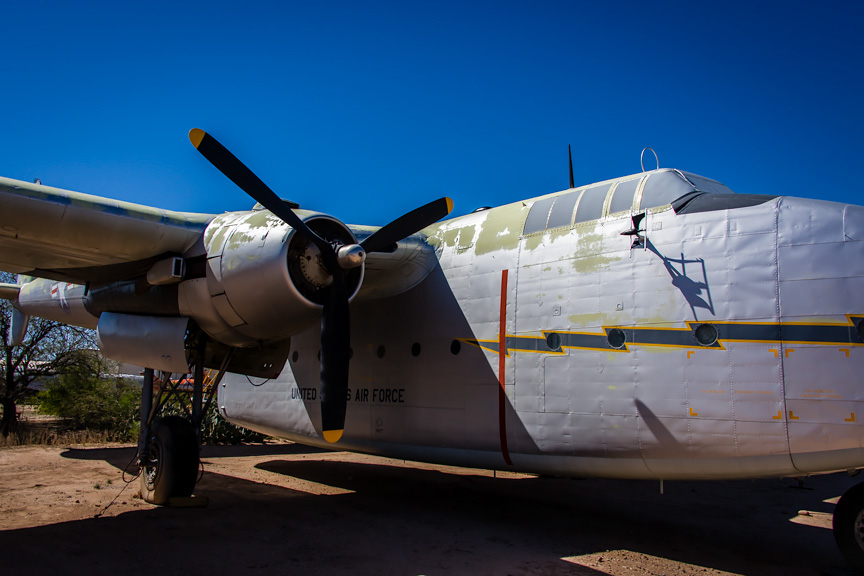 Next up is a Fairchild C-82 Packet — an unusual two-engine aircraft
with twin booms (the extension that holds the tail — hard to see in this photo). The aircraft was named as a tribute to the Packet Boats that hauled mail, passengers and freight in Europe and its colonies, including North American rivers and canals, for much of the 18th and 19th centuries.
Next up is a Fairchild C-82 Packet — an unusual two-engine aircraft
with twin booms (the extension that holds the tail — hard to see in this photo). The aircraft was named as a tribute to the Packet Boats that hauled mail, passengers and freight in Europe and its colonies, including North American rivers and canals, for much of the 18th and 19th centuries.
Designed in 1941 in response to an Army Air Force requirement for a new cargo plane capable of ground-level loading, paratroop operations, and glider towing, the C-82 incorporated a number of innovations that have become standard in military cargo aircraft. These include rear loading doors, a high wing, and an unobstructed cargo area. The rear passenger doors allowed the easy dropping of paratroopers and the removal of the rear clamshell doors allowed the dropping of larger cargoes and vehicles. The C-82 first flew in September 1944 and over 220 had been delivered when production ended in 1948.
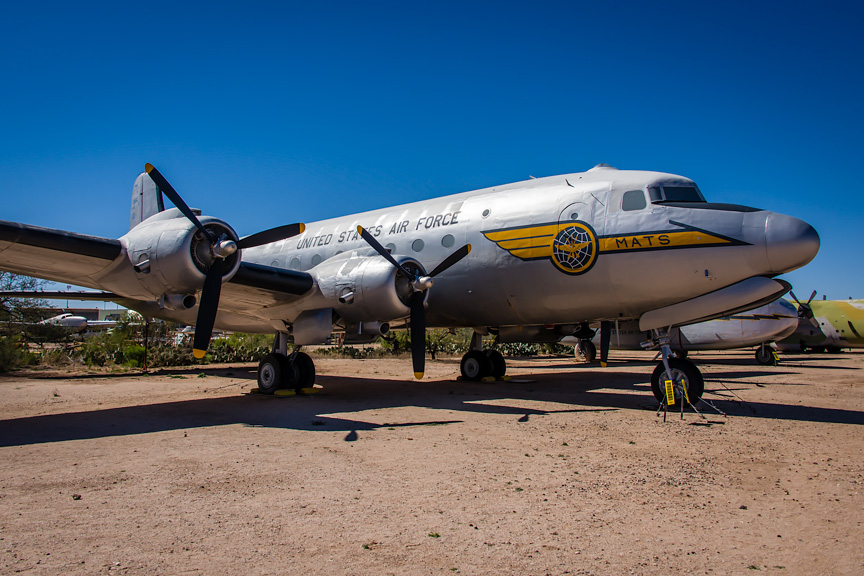 This is a Douglas C-54D Skymaster cargo aircraft, based on the civilian DC-4, and the first four-engine aircraft in the Army Air Force (predecessor to the U.S. Air Force). Interestingly, the first ones built were intended for civilian use but were commandeered by the Army in 1942 and converted for military use. Production was then moved to Chicago, providing aircraft for the war effort.
This is a Douglas C-54D Skymaster cargo aircraft, based on the civilian DC-4, and the first four-engine aircraft in the Army Air Force (predecessor to the U.S. Air Force). Interestingly, the first ones built were intended for civilian use but were commandeered by the Army in 1942 and converted for military use. Production was then moved to Chicago, providing aircraft for the war effort.
The C-54D is best known for service during the Cold War supplying Berlin during the blockage by the USSR and Warsaw Pact nations. The Allies, the U.S., Britain and France flew 2.3 million tons of cargo into West Berlin during the 15 months of the blockade — the largest humanitarian airlift in history.
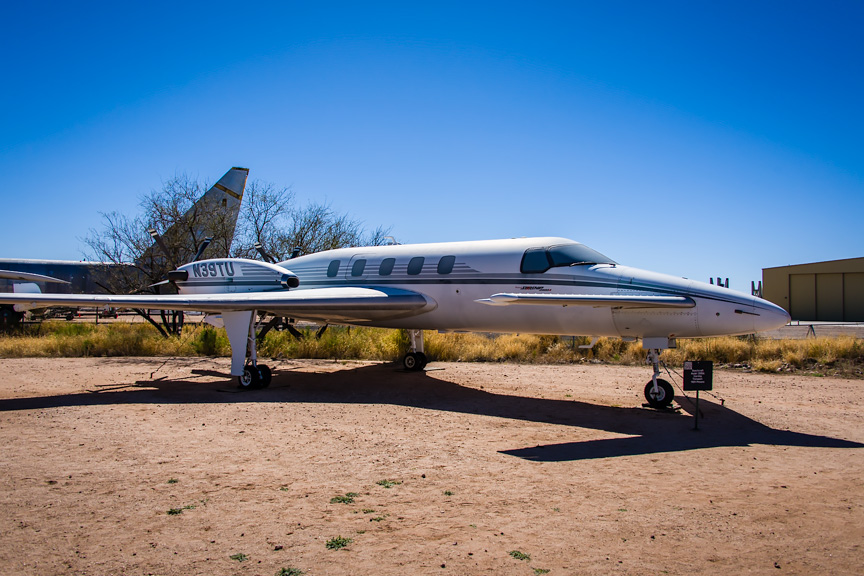 Looking like something out of a science fiction movie, the Beechcraft 2000A Starship, appears to be flying at a high rate of speed when it is just sitting in the Arizona sun. Unfortunately, one would need a high vantage point to provide a truly telling picture — click here to see the photo that the Museum has on their website.
Looking like something out of a science fiction movie, the Beechcraft 2000A Starship, appears to be flying at a high rate of speed when it is just sitting in the Arizona sun. Unfortunately, one would need a high vantage point to provide a truly telling picture — click here to see the photo that the Museum has on their website.
When it was built, the Starship was one of the most advanced aircraft of its type. Its development began in 1982 when Beechcraft contracted with Burt Rutan's Scaled Composites to refine a design they had begun in-house and to develop an 85% scale proof of concept (POC) aircraft. The POC was built and flown successfully albeit without some of the details planned for the production version, such as a pressurized cabin and approved avionics.
The design is unconventional in that it incorporates a two-pusher-prop configuration, no tail, winglets and a variable geometry canard. Oh, it also sports a carbon fiber composite airframe.
Beechcraft underestimated the engineering challenges of this design and overestimated the market for such an aircraft. Fifty-three were built but only 11 were sold — a few were leased. As of January 2010, nine Starships held an active registration with the FAA.
You can see a YouTube video of the Starship in flight by clicking here.
Today's last aircraft is a Sikorsky S-43 Baby Clipper, a smaller version of their S-42. It was introduced in 1934 and the primary user was Pan American World Airways for flights to Cuba and in Latin America. Three were used by Inter-Island Airways of Hawai‘i (the predecessor of Hawaiian Airlines) for flights between the Hawaiian Islands. The U.S. Navy purchased 17 with two assigned to duty with the Marines. Five were obtained by the U.S. Army Air Corps and used for transporting freight and passengers.
Note that this model is amphibious — able to land on land or on water. When landing on water, the wheels retract into that convenient recess in the side of the fuselage. The positioning of the wing and engines above the fuselage also facilitate those water landings.
